This post may contain affiliate links. Please read our disclosure policy.
These brown sugar and cinnamon frosted gluten free pop tarts are just like the “real” thing. Fill them with jam, nut butter, or a bit of Nutella to make them your family's favorite!
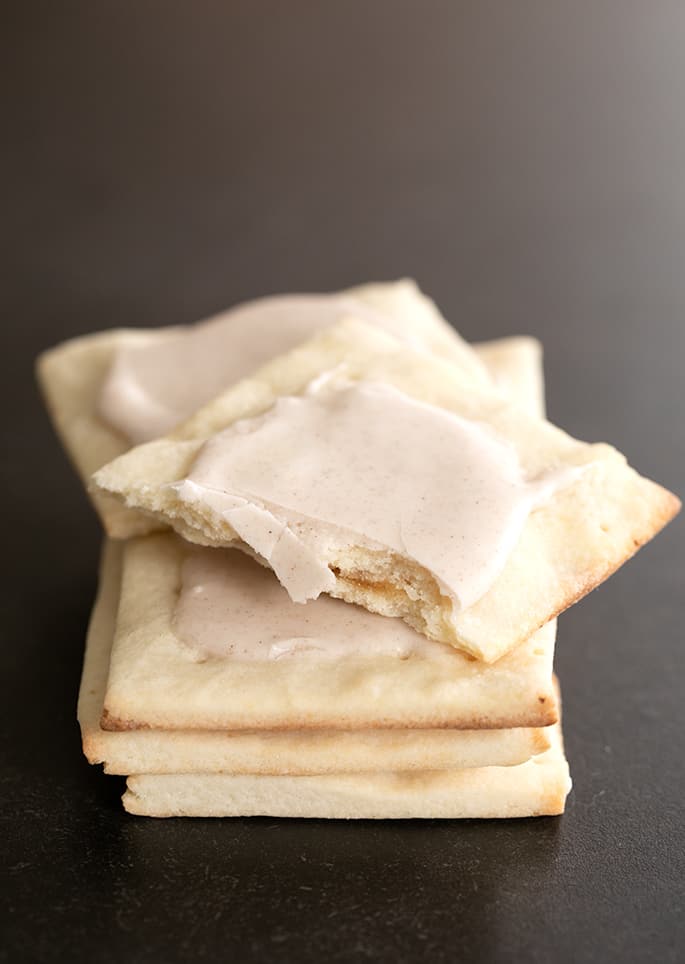
Table of Contents
Do you have memories of Pop Tarts for breakfast?
Pop Tarts were the breakfast of champions in the 1980's. I don't remember ever having anything else before school, latchkey kid that I was. And it seemed like such a good idea, too. Until an hour later when I was hungry again. Then, not such a good idea.
But I'd do it again the next day. We had a seemingly endless supply of them. I took that to mean that I was doing what I was meant to do by eating them every morning.
Filling options for these gluten free pop tarts
Everyone has a favorite kind. Frosting or not. Jam filling or brown sugar and cinnamon (the latter for me, thanks).
You can use 1 tablespoon of your favorite type of seedless jam in the center of each of these, instead of the brown sugar and cinnamon mixture. It should not leak, as long as you resist the urge to add too much. Same goes with Nutella or even a dab of peanut butter.
You can also make the same filling as we used for our McDonald's style handheld apple pies, with cooked diced apples with cinnamon and sugar as a filling.
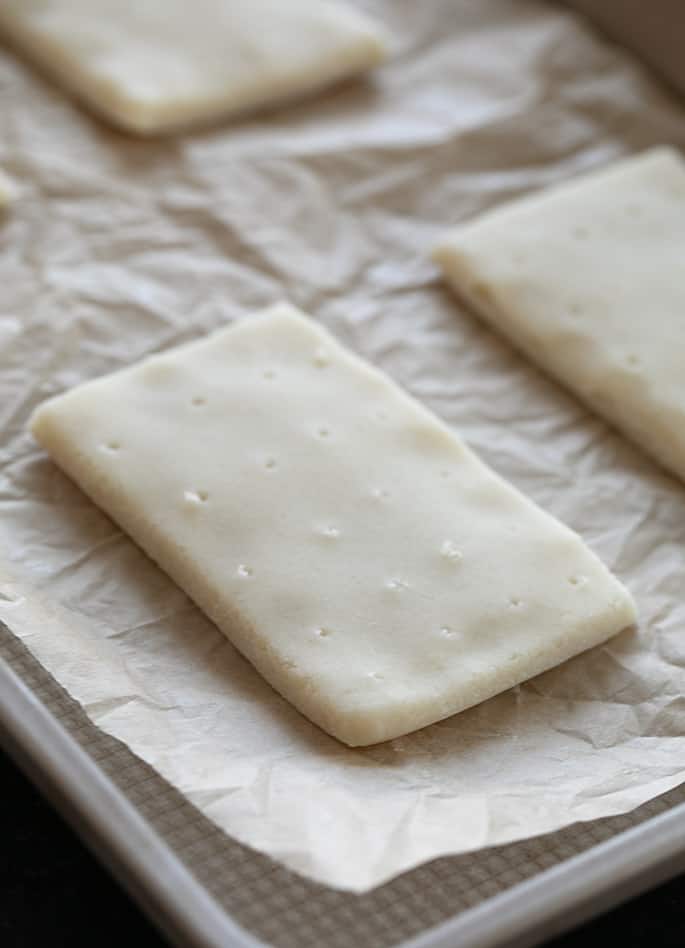
What makes these homemade gluten free pop tarts special?
You can make toaster pastries with a basic gluten free pastry crust. In fact, if you search for homemade pop tarts recipes, that's mostly what you'll find.
But if you want them to taste like the Pop Tarts you remember, you'll need a different crust recipe. In this recipe for gluten free pop tarts, the butter is melted, not cold like in traditional pastry.
The crust doesn't puff like pastry. Instead, it flakes, more like shortbread, but the crust isn't as fragile as shortbread cookies. And it's made with an egg, more like butter cookies.
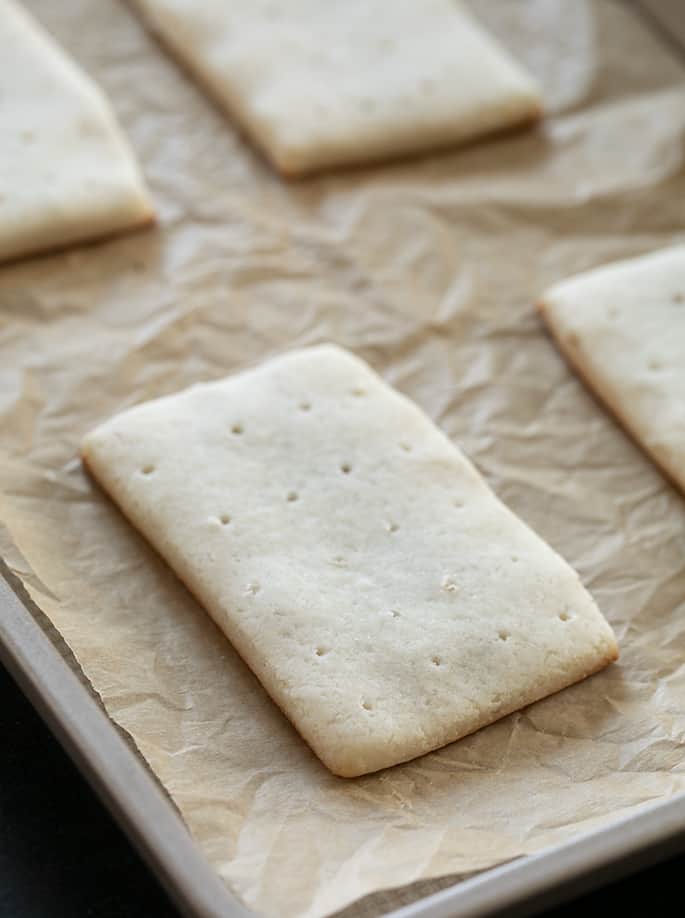
How to store and refresh these gluten free pop tarts
The finished pastries can be stored in a sealed glass container at room temperature and should maintain their texture for at least 3 days. Storing something in a glass container maintains texture, although a plastic container tends to make anything crispy become soft and weepy.
For longer storage, try piling the prepared pastries in a freezer-safe container (a rectangular container that is at least 5-inches tall is ideal). There's no need to freeze them first in a single layer, as they're very stable at room temperature. Once the glaze is completely set, it shouldn't be damaged in storing them.
To refresh them, do just what you do with a Kellogg's Pop Tart: pop it in the toaster oven! There's no need to defrost the pastries if they've been frozen. But remember that, if they're frosted, that part gets super hot so be careful with those fingers!
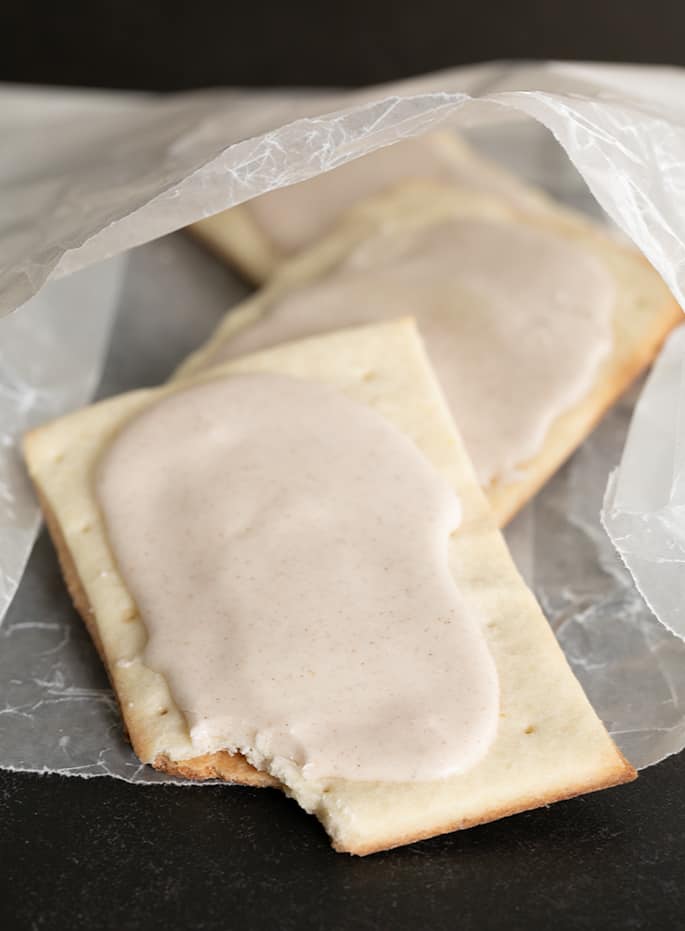
Gluten free Pop Tarts Ingredients and Substitution Suggestions
Gluten free dairy free pop tarts
The butter in the crust is the essential dairy in this recipe, and what you'll struggle to replace perfectly. I would try Melt brand or Miyoko's Kitchen brand vegan butter, or butter flavored Spectrum brand nonhydrogenated vegetable shortening. The milk can be your favorite nondairy milk, or even water.
Gluten free egg free pop tarts
There is only one egg in this recipe, but it really helps stabilize and add richness to the pastries. You can try replacing it with a “chia egg” (1 tablespoon ground white chia seeds + 1 tablespoon lukewarm water, mixed and allowed to gel).
Gluten free pop tarts without cornstarch
The cornstarch in this recipe can easily be replaced with arrowroot, tapioca starch/flour, or even potato starch. If you're using a higher starch blend like Cup4Cup, replace the cornstarch, by weight, with more Cup4Cup.
Gluten free sugar free pop tarts?
These are not “lightly sweet” breakfast cookies, like our oatmeal breakfast cookies. When I give them to my children, I do not kid myself that they're “healthy.” There is plenty of sugar in the dough, and the filling.
If you're really motivated, the crust might work with a granulated sugar replacement (I like Lankato brand monkfruit granulated sugar replacement), but those tend to be drying so you'll almost certainly need more moisture. The risk is that the dough will be tough, since sugar is a tenderizer.

No, Kellogg's brand Pop Tart toaster pastries are not gluten free, as they are made with wheat flour. They do not have a gluten free variety, either.
Yes, there are a few companies that sell gluten free toaster pastries. If you'd like to try some of them, the brands are Katz, Bobos, and Flings toaster pastries. Glutino used to make a variety, but they've been discontinues. In my opinion, the only ones that come at all close to tasting like the “real thing” are Katz, but they're a distant second to this recipe for homemade gluten free pop tarts.
No, Pillsbury Toaster Strudel handheld pastries, like Kellogg's Pop Tarts, contain wheat flour so they are not gluten free.
Yes, these pastries actually keep very well. Just bake them fully, let them cool, add the glaze and let it set fully, then wrap the pop tarts individually with freezer-safe wrap. Place them in a single layer on a flat surface, and place that surface in the freezer for 30 minutes to an hour. Pile the pastries into a freezer-safe zip top bag, and return to the freezer for up to 3 months.
Unwrap a frozen pastry, and place it in the toaster oven. Turn the toaster oven on to 300°F and bake until warm throughout. Alternatively, you could let the frozen pastry sit at room temperature until it's defrosted and either toast it or enjoy it as is.
Gluten free pop tarts recipe
Gluten Free Pop Tarts | Authentic Taste
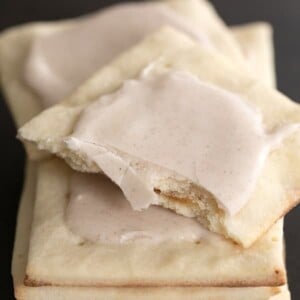
Ingredients
For the pastry crust
- 2 ¼ cups (315 g) all purpose gluten free flour blend, (I used Better Batter; click thru for info on appropriate blends), plus more for sprinkling
- 1 teaspoon xanthan gum, omit if your blend already contains it
- ¼ cup (36 g) cornstarch
- ¼ teaspoon kosher salt
- ¾ cup (150 g) granulated sugar
- 8 tablespoons (112 g) unsalted butter, melted and cooled
- 1 teaspoon pure vanilla extract
- 1 (50 g (weighed out of shell)) egg, at room temperature, beaten
- ¼ cup (2 fluid ounces) milk, at room temperature, plus more by the half-teaspoonful as needed
For the filling
- ½ cup (109 g) packed light brown sugar
- 1 tablespoon (9 g) cornstarch
- ½ teaspoon ground cinnamon
For the glaze
- 1 cup (115 g) confectioners’ sugar
- ¼ teaspoon ground cinnamon
- 2 teaspoons lukewarm water, plus more by the half-teaspoonful as necessary
Instructions
- Preheat your oven to 350°F. Line a large rimmed baking sheet with unbleached parchment paper and set it aside.
Prepare the crust.
- In a large bowl, place the flour, xanthan gum, cornstarch, salt, and granulated sugar, and whisk to combine well.
- Create a well in the center of the dry ingredients and add the melted butter, vanilla, beaten egg, and 1/4 cup milk and mix to combine. The dough will be thick.
- Knead the dough with your hands until it’s smooth, adding more milk by the half-teaspoonful as necessary to bring the dough together.
- Divide the dough into two equal parts and work with one at a time, covering the other with plastic wrap or a towel to prevent it from drying out.
- Place the first piece of dough on a lightly floured surface and dust lightly with more flour to prevent it from sticking. Roll out the dough about 1/4-inch thick, moving the dough frequently and sprinkling it with more flour as necessary.
- Slice it into rectangles approximately 3-inches x 4-inches. Reroll each rectangle a bit more until it’s a bit less than 1/4-inch thick.
- Gather and reroll scraps, and repeat with the other half of the dough. There should be at least 24 rectangles in total. If you have fewer, try for at least an even number of rectangles because you’ll be pairing them.
Prepare filling/assemble pastries.
- Placing all the filling ingredients in a small bowl and mixing them to combine well.
- Place about 1 tablespoon of filling in the center of of half of the rectangles of dough and spread it into an even layer, leaving about a 1/2-inch border clean on all sides.
- Cover the filling on each rectangle with a matching rectangle, and press all around the clean edge to seal. Trim any unmatched or jagged edges.
- Place the pastries about 2-inches apart from one another on the prepared baking sheet. Dock the pastries by piercing them all over the top with a toothpick or the tines of a fork.
Bake the pastries.
- Place the baking sheet in the center of the preheated oven and bake until the pastries are very lightly golden brown on the edges and set in the center, about 8 minutes.
- Remove from the oven and allow the pastries to cool completely.
Make the glaze/glaze the pastries.
- In a small bowl, place the confectioners’ sugar and ground cinnamon, and mix to combine well. Add the 2 teaspoonful of water and mix until combined into a thick paste.
- Add more water by the half-teaspoonful as necessary to create a thickly pourable glaze.
- Spread the glaze generously on top of each cooled pastry. Allow to set completely at room temperature.
Video
Notes
Nutrition
Nutrition information is automatically calculated, so should only be used as an approximation.
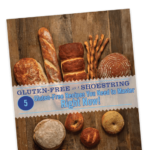

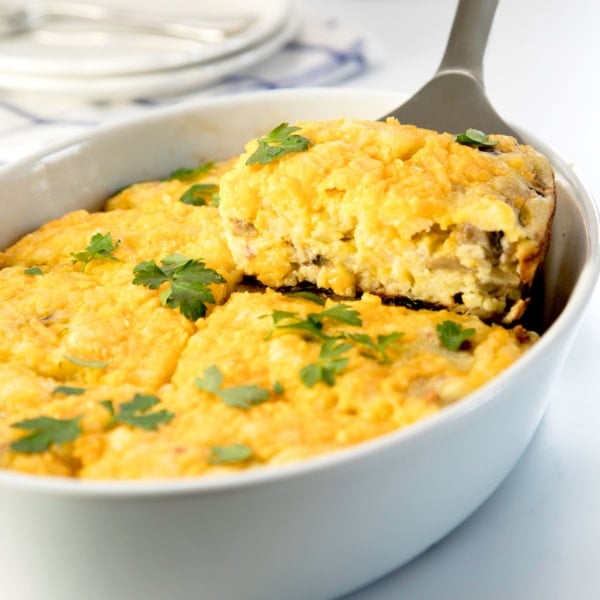
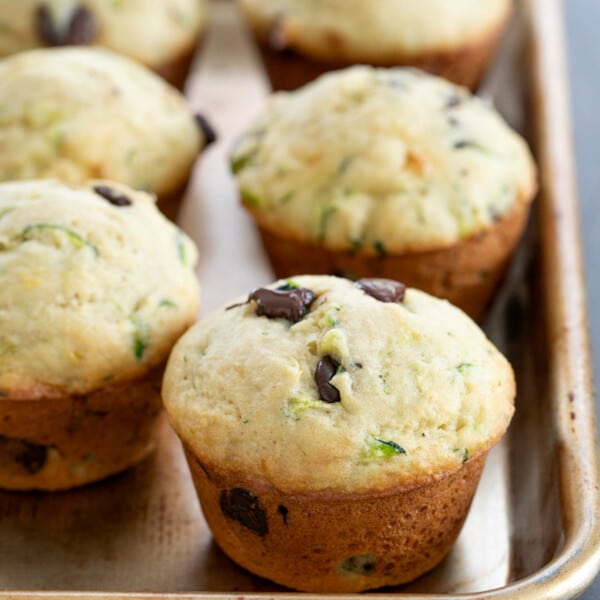

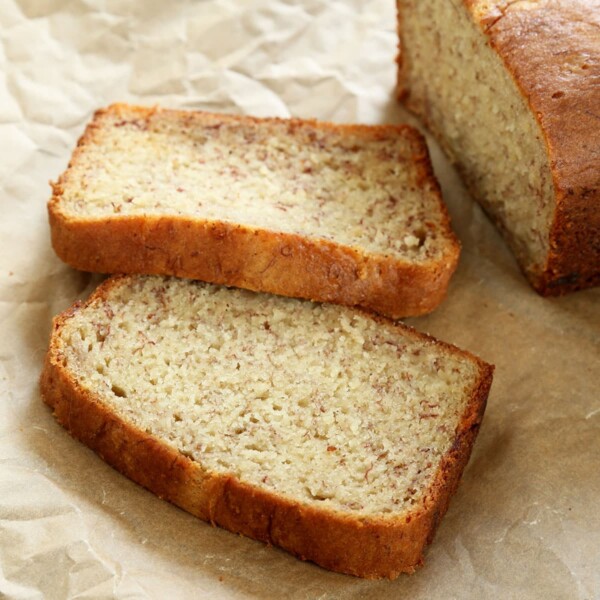









OMG I just stumbled across your blog (pinterest I think) and I LOVE YOU! You’ve got recipes for everything on here and it is so awesome to breath easy that when I have kids I’ll be able to give them the same treats other kids have without giving them something that (well if they take after me) will give them years of hell if eaten reagularly. Thank you thank you and thank you :D
Thank you. Thank you. Thank you. Thank you. Thank you. Thank you! I miss pop-tarts so much. :)
THANK YOU! I have been scouring the internet to find a pop-tart like recipe for our son… most look like pie crust, which doesn’t seem right! He has never had one since his wheat and soy allergy was discovered before he had the chance to try one! I feel like he misses out on so much because of that! I am going to do lemon curd & cream cheese, cherry & vanilla curd, and apple cinnamon! He is going to be THRILLED!
I also am a huge fan of your cookbook and can’t wait for #2 to come out! Thank you for continually making recipes so both my kids can enjoy some of the staples of childhood!
I made these this morning while my kids were still asleep. My gluten eating son was the first one up and is eating one right now. I put cinnamon, brn sugar and butter in the middle. He proclaimed that they are sooooo good and that I have become a master chef like person. hahahah. Thanks Nik!!!!
One time in college I had (this is insane) 2 s’mores pop tarts and a Mountain Dew. I vibrated for days.
Hm. Peanut butter and jelly GF pop tarts? Any reason why it couldn’t be done?
You can really put whatever you like in between these layers of pastry, Jen, as long as it’s thick so it doesn’t fall out during baking. Why not PB&J? Just be sure the J is actually jam, not jelly.
xoxo Nicole